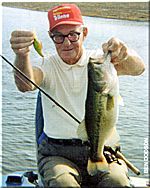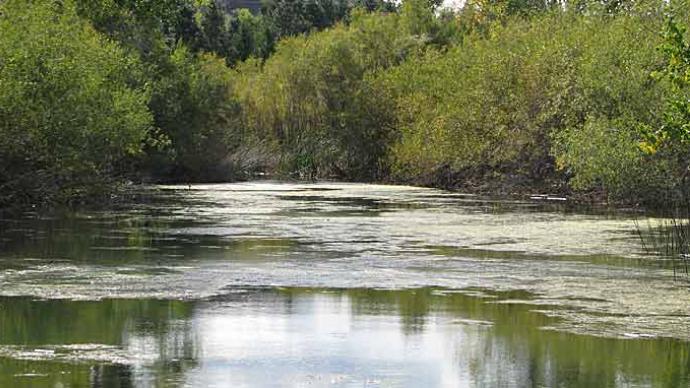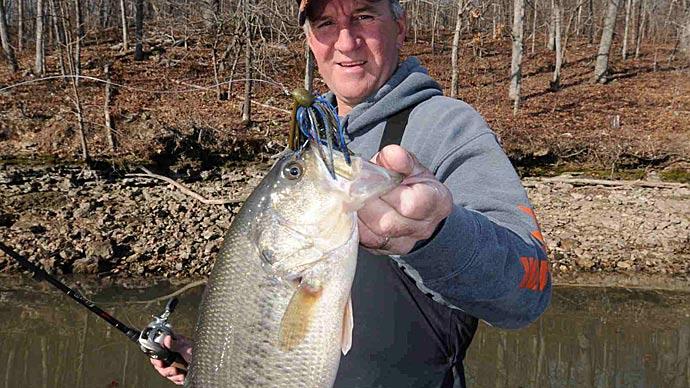
The post spawn period offers some interesting challenges for the bass fisherman. Some folks offer the concept that this period actually is somewhat akin to the dog days of summer in that the bass tend to get very finicky in their feeding habits. Actually things are usually relative to something and in this case it is the more reliable patterning that bass adopt in the summer.
In part, the consistency of the early and mid-summer is because things get stable. Baitfish school often along the same structure, at the same time on subsequent days. The bass also tend to reorganize from the scattered spawn and post spawn period into schools, and often show up at the same time and place to feed on concentrations of forage.
Things aren't the same for the post spawn period. For starters there are still fluxes in the weather including the passage of weak, but distinct fronts.
The next issue is the majority of the bass may be on the nest at the same time, but fishermen often misjudge the actual period of this activity. The factors of proper water temperature, length of daylight, and proper maturation of eggs for the spawn to begin are all predestined by nature's scheme of survival and the flux of days or weeks mean little to the bass.
The other factor is that there are bass that start earlier or later than the majority. Therefore it isn't hard to quickly recognize there are a lot of variables influencing bass during this period.
There is actually a stable period of fishing just before the major spawn for some of the same reasons that the summer gets reproducible patterns. In this case the concentration of fish in shallower water is due to the need of accumulating food reserves for energy during the non-feeding spawn intervals. The attraction has nothing to do with schooling patterns, but rather the earlier hatch of crayfish, which therefore are in abundance and concentrated in this portion of the lake.
You might think that a bass that is coming off a period of non-feeding (spawn) should be an aggressive feeder, but remember these are weakened and stressed fish. So the female may truly be somewhat lethargic until she regains strength. In fact the stress is why it is not uncommon to find some females in May and June that weren't able to recover.
So let's consider some of the issues that we have to reason through in order to develop a strategy for fishing the post spawn. To begin with we have a scattered population of fish. The second consideration is what are the readily available food source's that are easier prey for the tired fish? This one is fairly simple in that a whole array of small green things is in abundance in the spawn or immediate post spawn area. These include all the members of the sunfish family that bed after the major spawning period for bass. These critters are like the bass in that they don't easily want to leave their nest and so become easy pickings. There also are young of many members of the amphibian family becoming a bite- sized morsel during this time. A major post spawn food source is also the newly hatched bass fry. The adult bass consume considerable numbers of their own kind.
There are some common threads in using the previous thought process for planning your strategy for post spawn fishing. The first is based on the logic that most of the aforementioned post spawn foods are, in part or in the majority, green or chartreuse in color. There are on a number of these (particularly the sunfish) an orange minor color. It isn't an accident that many of the most successful firetiger-type color cranks combine these major tones. It always amazes me that a lot of folks don't use baby bass color crankbaits. The fact is that the crankbait specialist will often have a darker green baby bass that he will use in clearer water and a paler color version for less clear water.
These variations more accurately pattern the actual color of bass in these conditions. Another factor to remember about post spawn bass is that they are more likely to hit a slower worked lure than when in more active and aggressive schools in the summer. So exploit this in the type of lures you select and the presentation you offer. A soft or hard jerkbait will often be more effective in triggering a strike than a more rapidly worked lure. It is also a reasonable idea to think, "suspend" when bringing in diving baits. You need to use longer than usual breaks in the retrieve cycle once you have cranked the plug to the desired depth.
Obviously baits such as lizards and jigs, which are designed to be worked slowly, are ideal for fishing during this period. However, be warned I have found some bass to be so locked into the "chartreuse mode" that you had to force feed them any other color of jig or lizard. While the concept of big lure-bigger bass plays well in the pre-spawn period, many of the post spawn foods will be smaller versions. Planning to use baits that standout as being the wrong size in matching the prevalence of the food in the area can reduce your catch efficiency.
Bass tend to favor certain areas within a region for spawning. So while I noted earlier that the bass tend to be scattered during this post spawn period, they will have some favorite haunts. Thought of in a simple term, bass are creatures that like and follow structure. Thus it is only reasonable having spawned, those bass in certain areas of the lake will drop back to a common close by structure before retreating away from the area and forming summer schools.
The importance of this issue is that if you catch a fish on a given structure in the post spawn period you may just be onto a pattern. Such patterns may hold up in the given area or in similar areas over the lake. When making such judgements take note of both the water depth as well as the surface temperature. These are critical factors that determine not only the spawn but post spawn movements and habits.
I have touched on one other issue that needs attention at any time of the year, but is especially critical in periods when bass are coming off maximum stress. I don't use the term "stress" to explain any event where bass die, but do emphasize that a post spawn bass is a worn out animal. It has survived the pressure of making it through the cold of winter and the exhaustion of going through the laying of the eggs, guarding the nest and in some cases avoiding being foul hooked and a period of non-feeding. So if you catch a post spawn fish, keep it if you like, but otherwise treat it with extreme care and release it immediately to assure maximum potential for it to survive.




